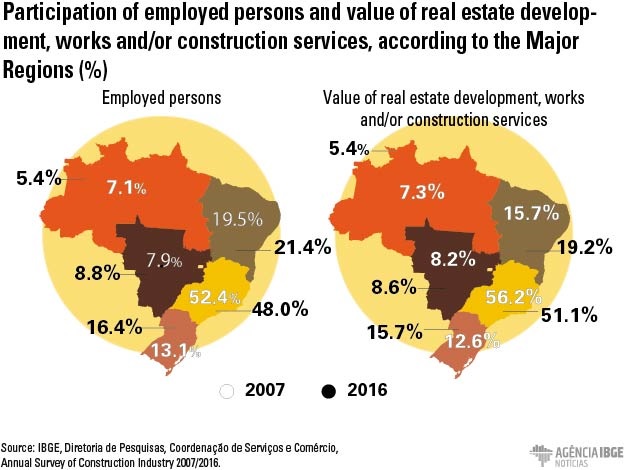Construção civil
Infrastructure works lose share in sector in 10 years
June 07, 2018 10h00 AM | Last Updated: June 11, 2018 10h30 AM
The share of infrastructure works in civil construction strongly dropped between 2007 and 2016, changing from 41.3% to 29.5% of the value added. As the investments in public works decelerated, building construction and specialized services increased. These data are in the Annual Survey of Construction Industry - PAIC, released today by the IBGE.
According to José Carlos Guabyraba, manager of the survey, "the retraction of the infrastructure works in Brazil that year was due to political, economic and business problems, resulting in a structural change in this sector".

In 2016, all the economic indicators dropped, causing a retreat of 3.6% in the Gross Domestic Product - GDP. The result was even worse in the construction industry, which registered -5.2%. In this scenario, the sector recorded a gross revenue of R$319.6 billion. The value of works and construction services hit R$299.1 billion, from which 31.5% came from works hired by public entities.
A total of 127 thousand enterprises were active in the construction industry that year, employing about two million persons. The expenses with wages, withdrawals and other compensation reached R$58.5 billion and the average monthly wage, R$2,235.16.
Among the products and/or services provided by enterprises, the construction of highways, railways, urban works and special artwork fell from the first to the fourth position between 2007 and 2016. As a result, residential works advanced in the ranking, changing from the fifth to the first position between 2007 and 2016.
The Northeast registered the highest growth in the value of works and services, changing from 15.7% in 2007 to 19.2% in 2016. Despite the drop in the share, the Southeast accounted for more than half of the sector (51.1%).
"This reflects the deconcentration process in the economy, where the Southeast loses share and the Northeast and North gains it", completes Guabyraba.




















